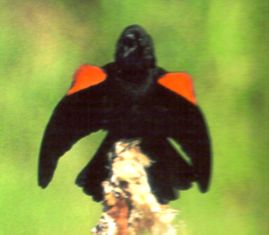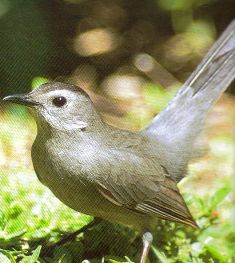Discover Florida Nature
It's time to explore the natural Florida


|
|
|
|
|
 Red-Winged
Blackbird- Male Red-winged Blackbirds are hard to
mistake. They're an even glossy black with red-and-yellow shoulder
badges. Females are crisply streaked and dark brownish overall, paler on
the breast and often show a whitish eyebrow. Because of its fascinating
red patch, this bird is sometimes simply called a "red-wing, even though
the entire wing is not red. When the red winged blackbird gets excited,
small muscles raise a few black feathers revealing the bright red
feathers underneath. Researchers who captured some of these birds and
covered their red patches discovered that these birds lost both their
territories and the ability to attract mates, showing how vital the
unique red patch on this bird really is! The Red-winged Blackbird is a
stocky, broad-shouldered blackbird with a slender, conical bill and a
medium-length tail. Red-winged Blackbirds often show a hump-backed
silhouette while perched; males often sit with tail slightly flared. One
of the most abundant birds across North America, and one of the most
boldly colored, the Red-winged Blackbird is a familiar sight atop
cattails, along soggy roadsides, and on telephone wires. Red-Winged
Blackbird- Male Red-winged Blackbirds are hard to
mistake. They're an even glossy black with red-and-yellow shoulder
badges. Females are crisply streaked and dark brownish overall, paler on
the breast and often show a whitish eyebrow. Because of its fascinating
red patch, this bird is sometimes simply called a "red-wing, even though
the entire wing is not red. When the red winged blackbird gets excited,
small muscles raise a few black feathers revealing the bright red
feathers underneath. Researchers who captured some of these birds and
covered their red patches discovered that these birds lost both their
territories and the ability to attract mates, showing how vital the
unique red patch on this bird really is! The Red-winged Blackbird is a
stocky, broad-shouldered blackbird with a slender, conical bill and a
medium-length tail. Red-winged Blackbirds often show a hump-backed
silhouette while perched; males often sit with tail slightly flared. One
of the most abundant birds across North America, and one of the most
boldly colored, the Red-winged Blackbird is a familiar sight atop
cattails, along soggy roadsides, and on telephone wires.  Cardinal-
The cardinal is one of the most popular and beloved birds, so
much so that seven states list the cardinal as their state bird. The
male cardinal is a bright red bird with a pointed crest on the top of
his head. The female is mostly buff brown in color with some red on her
head, wings, and tail. Both have small black masks on their faces that
surround the bill and eyes. Cardinals are permanent residents throughout
their range. At Your feeder you may see what is referred to as mate
feeding. What you'll see is the male picking up a seed, hop over to the
female, and the two momentarily touch beaks as she takes the food.
Mate-feeding continues through the egg-laying and incubation phases of
breeding. The female builds the nest while the male keeps a close eye on
her and the surrounding territory for predators and other males. The
female will be the only one incubating the eggs. Cardinal-
The cardinal is one of the most popular and beloved birds, so
much so that seven states list the cardinal as their state bird. The
male cardinal is a bright red bird with a pointed crest on the top of
his head. The female is mostly buff brown in color with some red on her
head, wings, and tail. Both have small black masks on their faces that
surround the bill and eyes. Cardinals are permanent residents throughout
their range. At Your feeder you may see what is referred to as mate
feeding. What you'll see is the male picking up a seed, hop over to the
female, and the two momentarily touch beaks as she takes the food.
Mate-feeding continues through the egg-laying and incubation phases of
breeding. The female builds the nest while the male keeps a close eye on
her and the surrounding territory for predators and other males. The
female will be the only one incubating the eggs.  Gray
Catbird- Gray Catbirds live amid dense shrubs, vine tangles,
and thickets of young trees in both summer and winter. In summer, Gray
Catbirds eat mainly ants, beetles, grasshoppers, midges, caterpillars,
and moths. When fruits are available they also eat holly berries,
cherries, elderberries, poison ivy, greenbrier, bay, and blackberries.
They are sometimes garden pests, eating or damaging raspberries,
cherries, grapes, and strawberries. Females build the nests, with males
sometimes supplying materials. Nests take 5-6 days to build. The final
product is a bulky, open cup made of twigs, straw, bark, mud, and
sometimes pieces of trash. It has a finely woven inner lining of grass,
hair, rootlets, and pine needles. Finished nests are about 5.5 inches
across and 2 inches deep. Catbirds usually build nests on horizontal
branches hidden at the center of dense shrubs, small trees, or in vines
The male Gray Catbird uses his loud song to proclaim his territory. He
uses a softer version of the song when near the nest or when a bird
intrudes on his territory. The female may sing the quiet song back to
the male. The Gray Catbird’s long song may last for up to 10 minutes. Gray
Catbird- Gray Catbirds live amid dense shrubs, vine tangles,
and thickets of young trees in both summer and winter. In summer, Gray
Catbirds eat mainly ants, beetles, grasshoppers, midges, caterpillars,
and moths. When fruits are available they also eat holly berries,
cherries, elderberries, poison ivy, greenbrier, bay, and blackberries.
They are sometimes garden pests, eating or damaging raspberries,
cherries, grapes, and strawberries. Females build the nests, with males
sometimes supplying materials. Nests take 5-6 days to build. The final
product is a bulky, open cup made of twigs, straw, bark, mud, and
sometimes pieces of trash. It has a finely woven inner lining of grass,
hair, rootlets, and pine needles. Finished nests are about 5.5 inches
across and 2 inches deep. Catbirds usually build nests on horizontal
branches hidden at the center of dense shrubs, small trees, or in vines
The male Gray Catbird uses his loud song to proclaim his territory. He
uses a softer version of the song when near the nest or when a bird
intrudes on his territory. The female may sing the quiet song back to
the male. The Gray Catbird’s long song may last for up to 10 minutes. Carolina
Chickadee- The Carolina Chickadee is one of the seven chickadee
species that occurs in North America. This bird is a southern version of
the Black-capped Chickadee and is found in Florida year round in
northern and central Florida. Carolina Chickadees look quite similar to
the northern bird but they do not have white edges on their wing
feathers. The chickadee says it name when it calls "chick-a-dee-dee-dee"!
Carolina Chickadees are popular with backyard bird feeding enthusiasts.
These birds are omnivorous with a diet consisting of seeds of ragweed,
mulberry, pine, redbud and sunflowers, and of insects such as aphids,
treehoppers, ants, bees and others. Carolina Chickadees are cavity
nesters. A woodpecker cavity, nest box or other suitable cavity may be
used. In decayed wood, both parents may excavate their own cavity. Sexes
are similar. Carolina Chickadee pairs remain mated for long periods that
may last over two or more nesting seasons. Banding studies show that the
Chickadee may live more than 10 years. The female incubates from 5 to as
many as 8 eggs that hatch in about 2 weeks. Both parents care for the
young that leave the nest in about two and a half weeks. Carolina
Chickadee- The Carolina Chickadee is one of the seven chickadee
species that occurs in North America. This bird is a southern version of
the Black-capped Chickadee and is found in Florida year round in
northern and central Florida. Carolina Chickadees look quite similar to
the northern bird but they do not have white edges on their wing
feathers. The chickadee says it name when it calls "chick-a-dee-dee-dee"!
Carolina Chickadees are popular with backyard bird feeding enthusiasts.
These birds are omnivorous with a diet consisting of seeds of ragweed,
mulberry, pine, redbud and sunflowers, and of insects such as aphids,
treehoppers, ants, bees and others. Carolina Chickadees are cavity
nesters. A woodpecker cavity, nest box or other suitable cavity may be
used. In decayed wood, both parents may excavate their own cavity. Sexes
are similar. Carolina Chickadee pairs remain mated for long periods that
may last over two or more nesting seasons. Banding studies show that the
Chickadee may live more than 10 years. The female incubates from 5 to as
many as 8 eggs that hatch in about 2 weeks. Both parents care for the
young that leave the nest in about two and a half weeks.
|
|
|
Advertise | Privacy Statement | Contact | Alaska Nature | Michael Arnold Art| Dog Encyclopedia | Dog Encyclopedia| |
|